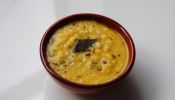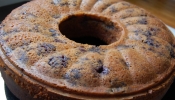I’ve been trying to help Max resolve his issues with sourdough for a little while. If you have ever tried to help anyone with their bread problems across the net you’ll understand how difficult it can be. There’s a process of eliminations of what could be the cause of things going wrong. The biggest problem for Max was the huge holes he was getting in the crumb but he was also unhappy with the thin crust on the bottom of his loaves.
I asked Max to send me the photos of his loaves.
Eventually Max got it, and saw what I was saying about proving times in the winter and how different it was from summer temperatures.
Getting Rid Of Large Holes
In the beginning of proving dough have you noticed how it forms super big gas bubbles?
This is good when producing breads like focaccia where big holes are sought after but here it’s not very good for holding butter. Gently folding dough keeping in those big gassy bubbles produce the focaccia I was after here. Before I achieve that result in that post I went through a few failures, analysing those failures one of the things I noticed was how pressing too hard when handling my dough bursting a lot of those large bubbles resulted in a ‘smaller’ open texture than I wanted.
Max was doing two things here, vastly under-proving the dough on the last rise which is why he has a tight crumb around the big holes, but also maintaing too many of those initial large bubbles. When folding it’s best not to be overly gentle with it in order to knock out some of the big bubbles.
To tackle the problem with tight crumb around the large holes is a matter of time, and when Max tried as I suggested to leave the dough anything from 7-12 hrs at room temperature on final rise he finally managed to achieve the crumb he was after.
Max’s Perfect Loaf
This loaf above and below was exactly what he wanted. After folding and shaping the dough he put into the basket to prove in the fridge overnight, then letting it at room temperature for 7 hrs to rise.
To achieve the harder thicker bottom he was after he ditched the baking stone and baked directly on a baking tray, the stone wasn’t heating up sufficiently. He followed my suggestion of taking loaf out of baking sheet for last 20mins to bake it directly on the rack of the oven.
The other advice he followed was to bake it for longer than he thought he should in order to dry it out completely inside to maintain a hard crust once out.
Afterwards he also experimented with another loaf adding some sieved wholemeal rye flour for extra flavour. Soon he’s going to try adding some stoneground flour, I think he’s now caught the bug of experimenting with flours.
It really does make a huge difference making a sourdough in this weather to the warmer months, even in a normal central heated room, you have to give it more time.
Max is now a happy baker and so am I.









































{ 8 comments… read them below or add one }
I had a hole in a loaf the other day (Dan’s potato bread from THML) that was so big it was like a cave! I will remember the tip about not being too gentle while folding.
Took a few failures with focaccia to get it Emily…and also remembering things said by Paul Merry how folded doughs have tendency to do this..and even on Hamelman’s youtube clip there is a comment from him about bursting out some of the larger gas bubbles when shaping the dough, but for some very odd reason he says to burst because they’re not good for you which I just can not understand why he would say such an odd thing? Big bubbles are not better/worse for oneself than lots of little ones…I wish someone pointed out this to him before putting the video on youtube.
Surely he didn’t mean unhealthy…perhaps he was just being poetic, or meant they’re not good for the bread, can distort the shape, make it less pretty? I’ll have a look.
The way he says it sure comes across as it’s for one’s health which is why it has had me puzzled all this time..but putting together this post and thinking about large gassy bubbles it made me think maybe that’s what he meant? It’s the youtube clips with King Arthur’s Flour, I think it’s the one he does the dividing of the dough..but it’s been months since I’ve seen the clip.
Great instructional post. I’m planning to try making sourdough at the end of this month and am lapping up as much information as I can before that first attempt!
I have trouble with my SD dough being sticky – I use your ‘inbowl’ mixing/kneading/stretching method, which is brilliant (use it for yeasted as well)..On Friday, I started my SD off around 0830 (working at home all day), and yeasted (wholemeal and white) afterward. I tend to stretch/fold the yeasted at 45 min intervals (usually 2/3 times), and the SD every other. I shaped the yeasted at around 11.15, stretched the SD again; baked the yeasted at around 2 – found my wholemeal was over proved, so lacking oven spring…and left the SD to prove until around 6 (coolish kitchen) it had rtisen well all day bewteen stretching – and then shaped it, into a round baneton the dough was a bit sticky, so needed a very light dusting to make it handleable; Oven on at around 2030, tipped onto sheet at around 2100 (took a while to tip out – had to help it)….baked nicely, with good spring – but – how can I get round the stickiness? It tastes fine, and usally has good crumb, but I can never get my boule loaves to look like yours, with that great crust!
I use my SD recipe from loafonline – from my course – 200g preferment, 520 flour, 275 cold water, 9 g salt. my starter is kept in the fridge, and refreshed overnight prior to bakimg. I’ve tried the double build method, but had limited success with that…sorry to ramble..
Simon I’ll come back when I can properly answer your questions.
Stickiness Simon is down to how much water you have in your SD recipe in relationship to the type of flour you have. I don’t prove my loaves in a baneton for the simple reason you mention that mine would sometimes get stuck and when baking only one loaf the frustration of getting a splat of a loaf was too much for me to bear. However I do hear that dusting your baskets with rye wholemeal flour helps or rice or semolina flour are also suggestions I’ve heard.
For Crust Colour:
1 -I bake my loaves in a really hot preheated oven..45mins beforehand and bake it for longer than I would naturally want to to get a good dry crust.
2 -Proving like I do on a baking sheet as appose to inside a basket covered in flour will also mean I won’t have a lot of flour drenched over the crust…my flour on top is lightly sprinkled just before going in oven therefore it sits on top of the dry crust already formed while rising..doesn’t penetrate the crust.
3- Leaving your dough overnight and then proving as you do also helps with crust colour as there will be more natural sugars in the crust from long fermentation..you can see from the photos of Max’s loaves he has good colour crust and proves in baskets like you.
4- And last but not least FLOUR makes all the difference, different flour will contribute to great crisp crust & colour, it really matters. High gluten flour produces a less desirable crust than the lower protein flours.
I don’t understand however if you’re only using 275g of water to 520g flour how your dough is sticky but then I don’t know how you feed your leaven nor what flours you’re using.
I hope this helps.